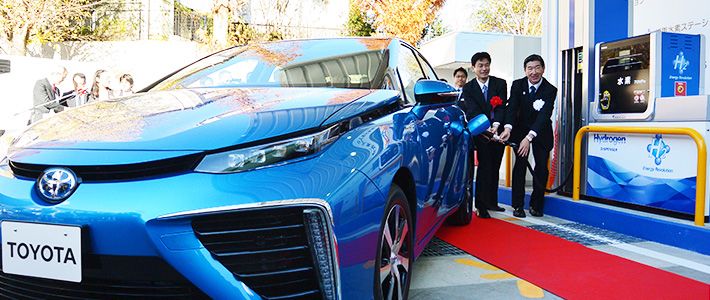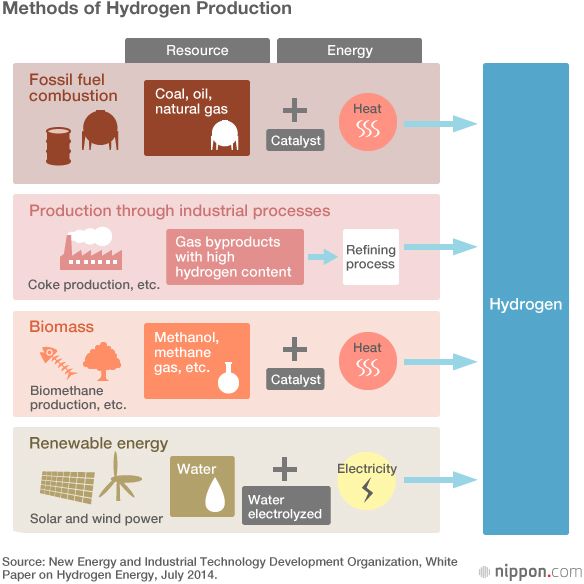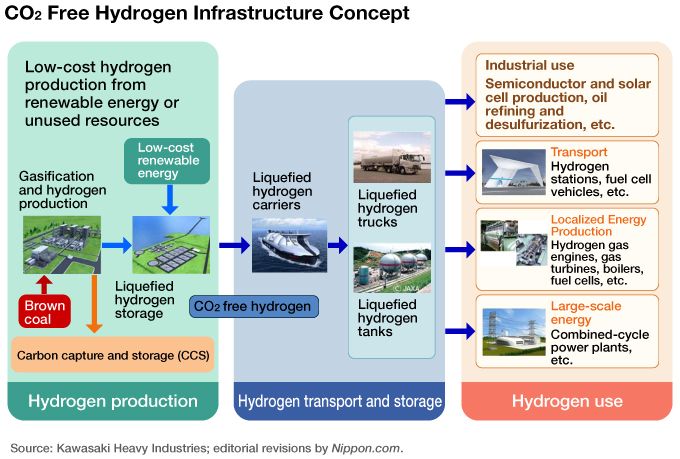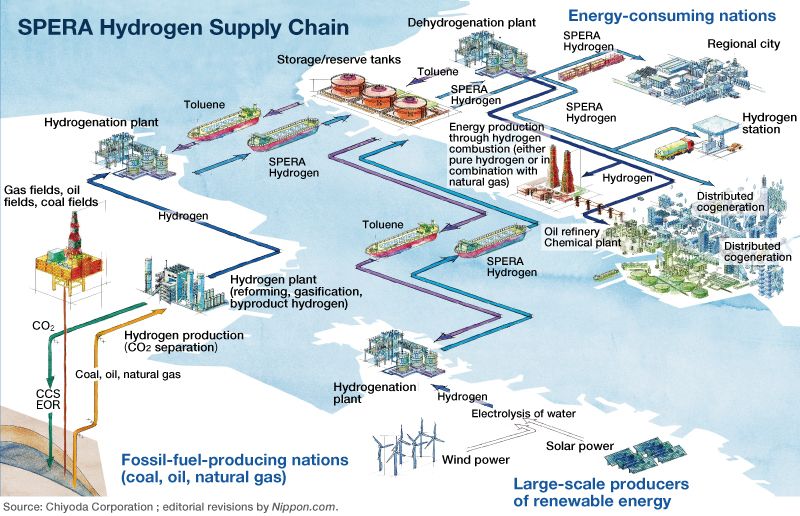
The Hydrogen Revolution: Game-Changing Developments Loom for Global Energy Supply
Economy Science Technology Society- English
- 日本語
- 简体字
- 繁體字
- Français
- Español
- العربية
- Русский
Long-Awaited Progress on Hydrogen Energy
The year 2014 was when real progress finally started to be seen in the use of hydrogen energy. In June, the Ministry for Economy, Trade, and Industry’s Council for Strategy on Hydrogen and Fuel Cells compiled its “Strategic Road Map for Hydrogen and Fuel Cells.” And November saw a major step toward the Tokyo Metropolitan Government’s goal of realizing a “hydrogen society” by the time of the 2020 Tokyo Olympics and Paralympics with the release of a list of concrete measures and budgetary provisions. Around that same time, both Honda and Toyota Motors confirmed plans to put hydrogen fuel cell cars on the market. And two other firms––Iwatani Corporation and JX Nippon Oil & Energy Corporation––announced prices for the sale of hydrogen at hydrogen stations. All the gears seemed to have ground into action at once.
Japan had already taken the global lead in the implementation of hydrogen fuel cell technology. In 2009 Panasonic teamed up with Tokyo Gas to launch Ene-Farm, a pioneering electrochemical fuel cell for the home. And in December 2014 Toyota unveiled the world's first mass-market fuel cell car, a development that attracted much media attention.
Five Potential Benefits
The great potential benefits of hydrogen energy can be summed up in five main points.
First, because the use of hydrogen as a fuel produces no carbon dioxide or other greenhouse gases (the only byproduct is pure water), it is considered to be a “green” fuel. This eco-friendly status, however, extends only to the actual use of hydrogen, and not to its initial production. Because such merits are negated if fossil fuels are used in production of the gas, hydrogen production via renewable energy sources is a preferable option in order to reap the full environmental benefits.
Second, because hydrogen fuel cells are exceptionally energy efficient, they have great potential in the ongoing drive to curb overall energy consumption. At present, around 60% of the energy at facilities operated by Japan’s electric power companies ultimately goes to waste, a figure that could be reduced considerably through the use of fuel cells. In addition, fitting stationary fuel cells to homes and other buildings would enable premises to cover their own heating and electricity needs, further contributing to reductions in energy use.
Third, hydrogen energy has the potential to boost disaster preparedness. In the event of a serious earthquake or other such catastrophe, homes and vehicles fitted with fuel cells could be used as emergency power sources, thereby safeguarding both lives and living conditions.
The fourth point is, because hydrogen can be produced by a broad variety of means, its applications do not end with its potential as an energy source. It can also be used as a means of energy transportation, so, when paired with other energy sources, it can play a role in making up for their shortcomings and accentuating their strengths. In some ways, it is this potential to effect an overall change in the energy industry that perhaps holds the greatest appeal. This aspect will be covered in greater detail in the second half of this article.

The fifth and final point is of particular interest to Japan. This country leads the world in the development of the technology for hydrogen energy, and if the use of hydrogen advances, it has the potential to rejuvenate the Japanese economy and create new jobs. At present, Japan places first by a wide margin in the world rankings for the number of patent applications for technology relating to hydrogen fuel cells, and Japanese firms are also highly competitive in the manufacture of tanks for hydrogen storage. As in the field of geothermal energy, Japan’s companies have established a competitive edge when it comes to the use of hydrogen.
Obstacles Remain
But in order to realize the potential of hydrogen energy, there are still a number of issues that need to be addressed.
The biggest is the need to reduce costs. No matter how wonderful an energy source may be, it will not be widely adopted if it is prohibitively expensive. But while the main hopes for savings lie in further technological innovation, there are also a number of supplementary measures that can be taken. One is to pair hydrogen energy with other, cheaper means of power production, using the merits of hydrogen power while greatly improving overall cost performance. Another is to focus temporarily on improving hydrogen-energy-related infrastructure while using hydrogen produced as a byproduct of other, comparatively less expensive, means of energy production––particularly the burning of fossil fuels. As hydrogen infrastructure expands and mass production brings down the cost of further development, a gradual switch could be made to producing “green” hydrogen from renewable sources.
Another issue is ensuring support from the general public for the drive toward a hydrogen society. With this aim, the safety of hydrogen power must be clearly demonstrated, and fears that funding the initiative might lead to tax increases assuaged. Looking around the world, we see that moves to use hydrogen to contribute to localized energy supply are usually undertaken on a community-wide basis. The participation of residents is indispensable if a locally grounded hydrogen society is to be realized.
Another very real issue is the importance of establishing a hydrogen supply chain in a single sweep. Due to a lack of clarity over which should come first, the relationship between fuel-cell vehicles and the hydrogen stations on which they rely has often been unfavorably likened to that between the chicken and the egg. For too long, manufacturers of each technology viewed the spread of the other as a prerequisite for their own expansion, and sat back waiting for developments, with the result that neither made any significant progress. Recent advances, however, have seen the analogy revised to reference flowers and bees. Makers on each side have at last realized their mutual dependence and are expanding together in tandem.
Although Japan may be the global leader in terms of fuel cell development and usage, the country’s infrastructure still lags some way behind the rest of the world. The 2020 Olympic and Paralympic Games in Tokyo are seen as providing the perfect opportunity to focus the efforts of the nation and provide the impetus for a unified push to establish a hydrogen supply chain.
Two Potential Combinations
As mentioned above, one of the keys to expanding the use of hydrogen energy is to use it in conjunction with other, cheaper power sources, harnessing the qualities of hydrogen while boosting cost performance. Allow me to explain these methods in more detail.
Hydrogen and Coal for Zero Emissions
The pairing of expensive, yet eco-friendly hydrogen energy with coal, which is cheap but detrimental to the environment, is a highly complementary one. One concrete example of this is Kawasaki Heavy Industries’ project to create what it calls a “CO2 free hydrogen infrastructure,” based on the production of hydrogen using low-grade brown coal (also known as lignite) obtained from Australia.
Kawasaki has outlined a scheme in which a process known as gasification would be used to convert brown coal from open-cast mines in the state of Victoria into a mixture of gases, including hydrogen and carbon dioxide. The CO2 would be captured at source and stored in underground geological formations in a process known as carbon capture and storage (CCS), and the hydrogen could be shipped to Japan on special tankers to meet the needs of fuel-cell cars and hydrogen energy schemes in this country.

The realization of a project combining such practical application of both CCS and hydrogen energy could have great implications for the environment, but the benefits would not end there.
Within Australia itself, particularly in the state of Victoria, which has less of an endowment of high-grade coal than New South Wales or Queensland, the ammonia and urea produced as byproducts of the gasification process could be used by the chemical industry and in fertilizer production, constituting an effective use for this low-grade coal.
To Japanese companies participating in such a scheme, meanwhile, the benefits would be twofold. At the same time as assisting CCS in another country in a manner similar to bilateral carbon offsetting, they could also help to curb the ongoing rise in fuel prices that poses one of the greatest threats to Japan’s economy by contributing to a system that favors increased demand for cutting-edge coal-burning power stations. In this sense, the construction of a CO2 free hydrogen infrastructure could become a project with a double, or even triple, meaning. (Under the system of carbon offsetting, when greenhouse gas emission-reducing technology is exported from one country to another, the resulting cut in emissions is divided between the two countries.)
Making Hydrogen Easy to Transport and Store
Hydrogen energy can also be used in conjunction with oil, natural gas, wind energy, and solar energy. One example of such a scheme is the “SPERA Hydrogen” system developed by Chiyoda Corporation with a range of industrial applications in mind.
Spera is a Latin word meaning “hope.” Under the system proposed by Chiyoda Corporation, hydrogen generated at hydrogenation plants near oil and gas fields, coal mines, and large-scale wind farms, is combined with the solvent toluene as the easily transportable hydrocarbon methylcyclohexane (MCH), which is liquid at room temperature and pressure. The MCH can then be transported to dehydrogenation plants elsewhere in Japan or further afield, where the hydrogen is extracted and used as fuel. The separated toluene can be returned to hydrogenation plants and reused.
The point of this plan is to make hydrogen, which is normally highly volatile, easy to transport and store by converting it to MCH, and Chiyoda Corporation has named this easy-to-use form of hydrogen “Spera Hydrogen.” The “hope” relates to the potential benefits for humanity from the effective use of hydrogen.
As the first step, Chiyoda Corporation plans to build hydrogenation plants in coal-, oil-, and gas-producing regions to combine the hydrogen produced there with toluene. In that situation, the carbon dioxide given off at the moment of hydrogen conversion could be stored using CCS, greatly reducing carbon emissions. In the case of oil fields, this CO2 could then be reused to extract as much oil as possible in what is known as enhanced oil recovery (EOR), thereby also bringing benefits in terms of increased oil production.
The second step will be to use electricity generated by renewable means such as wind and solar to electrolyze water, thereby producing hydrogen and oxygen, and the hydrogen converted to MCH for use later on. With CO2 emissions of virtually zero, solar and wind power are viewed as vital tools in the fight against global warming. In many cases however, the need to build costly power lines is delaying progress. If employed successfully, Spera Hydrogen has the potential to solve this problem by replacing power lines and allowing energy to be transported. In other words, Spera Hydrogen also has great potential for furthering the uptake of both wind and solar power.
Potential for Fundamental Change
An additional application is starting to be gain traction in Europe. “Power to gas” is another procedure in which surplus electricity is used to electrolyze water into its constituent elements, hydrogen and oxygen. This hydrogen is then in jected into the gas grid and used as gas. This approach does not require power lines and makes use of surplus electricity from wind farms and other sources that would otherwise go to waste.
In this way hydrogen can be used to compensate for the flaws and take advantage of the strengths of other energy sources. The greatest appeal of hydrogen energy lies in its potential to fundamentally change the nature of the world’s energy supply.
(Originally written in Japanese and published on March 9, 2015. Banner image: A Toyota fuel-cell car is filled with hydrogen at Tokyo’s first commercial hydrogen station. Photo © Jiji Press.)
wind power electricity energy renewable energy solar power fossil fuels Tokyo Olympics hydrogen
